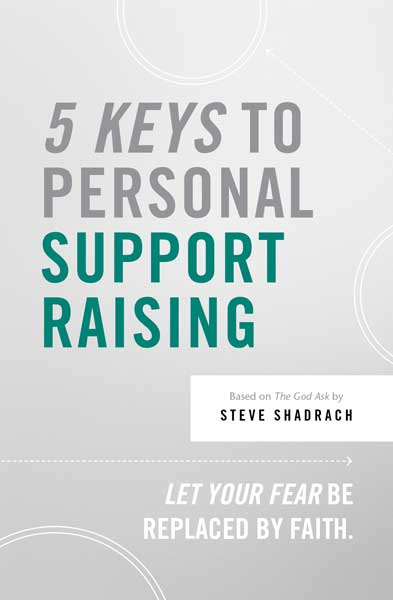
As we seek to help our new and veteran ministry workers become and remain spiritually healthy, vision-driven, and fully funded, how we train our people for ministry partnership matters. Every year, organizations of all kinds spend millions of dollars on training experiences for their personnel. Sadly, research suggests that the results of much of that training fail to live up to what was hoped for from the investment of such time and money. So what makes for effective training?
Carissa Potter’s blog article, Learning that Connects, from March 15th makes three important points about adult learning:
- Adult Learners are motivated by relevance
- Adult Learners have prior experience/knowledge
- Adult Learners are self-directed
If you haven’t read that article, I encourage you to do so. In addition to these three points, I’d add the following two principles for effective adult learning:
Adults learn by doing
Giving learners the opportunity to take new information and practice using it during the training experience helps to lock in concepts and helps both them and us know that they know how to do it.
As we’re designing we employ Achievement-Based Objectives: “By the end of this workshop, all participants will have….” We also design four types of learning tasks for each ABO:
- Inductive tasks connect the new material with learners’ past or current experience
- Input tasks present the new information for learners to process
- Implementation tasks give the learners opportunities to do something with the new information
- Integration tasks provide learners the chance to plan how they’re going to put the new information to use in their context.
Use three domains of mental activity for effective learning
Effective learning requires more than just the study of ideas and the sharing of information (cognitive domain). It also involves how we feel about the ideas and concepts we’re learning (affective domain) and what we can do (psycho motor or kinesthetic domain) with those ideas and concepts.
Effective training starts before the training event, with careful planning and design. Learning-centered training design begins with several critical questions, addressed in sequential order:
- Who will be the participants in this training? (numbers, ages, backgrounds, culture, language, levels of education, experience with the subject matter, etc.)
- Why are we and they participating in this training? (expectations – theirs and ours, perceived needs, desired long-term impact, history and context behind the training, etc.
- When will this happen? (dates, number of days and sessions, duration of sessions, other events happening in conjunction with the training, etc.)
- Where will this training be held? (location, available technology, equipment, seating, setting, etc.)
Only when we’ve answered the previous questions are we ready to address the next two design questions:
- So, what are wanting to come away with? (achievement-based outcomes)
- How are we going to help them learn? (learning tasks)
Good training design still needs to be facilitated well during the training event for the learning to be effective. Here are some principles for effective facilitation, either in person or online:
- Facilitation is about understanding that the learning experience is about helping the participants master and apply new knowledge and skills, not about how much material you can get through in the time allotted.
- The more control that is given to the learners in terms of making decisions and choices during the experience, the more real learning occurs.
- The most important skills for effective facilitation are listening, asking good questions, and coaching.
- Good facilitation is harder than good presentation, but it yields more real learning.
But even when we’ve designed and facilitated the perfect training experience, we might still fail to see the desired results. It’s been said that there are five points of learning needs for adult learners:
- When we need to learn some new information for the first time.
- When we need to go deeper and learn more about a new subject or area
- When we’ve forgotten what we learned in a training experience
- When things blow up and we need to access information quickly and easily
- When things change and we what we learned is now outdated
To address these five points of learning need, adult learners need three key things:
- Learning experiences in blended format (face to face, virtual, in a cohort, on-demand)
- Resources that are available just in time that can help us put what we’ve learned to work
- Relationships with others who are learning and those who can help us move forward – best practice advises us to never train anything we don’t intend to provide follow-up coaching for.
Finally, one of the reasons organizations keep spending massive amounts of time and money on training that doesn’t produce the desired results is that they don’t take the time to evaluate their systems and processes. Learning evaluation is not just about evaluating the learners, it’s also about an ongoing cadence of evaluating whether the training and learning support efforts are effective and making changes for continuous improvement. A model for evaluating training that has proven effective for many years is the Kirkpatrick model, now known as the New World Kirkpatrick Model, which evaluates learning at four levels:
- Level 1: Reaction – The degree to which participants find the training favorable, engaging and relevant to their contexts
- Level 2: Learning – The degree to which participants acquire the intended knowledge, skills, attitude, confidence and commitment based on their participation in the training
- Level 3: Behavior – The degree to which participants apply what they learned during training when they are back on the job
- Level 4: Results – The degree to which targeted outcomes occur as a result of the training and the support and accountability package, leading to favorable long-term impact for the organization and those it serves
I encourage you to spend time diving deeper into how your team and organization designs, facilitates, and evaluates your MPD training for your new and veteran staff, as well as all your training. As organizational leaders, I think we should always be asking the question, how are our people going to know how to do what we’re asking them to do?” Ultimately, we all have to take responsibility for our own personal performance. But when it comes to building the cultures, structures, and systems for supporting performance, that’s on us as leaders.

